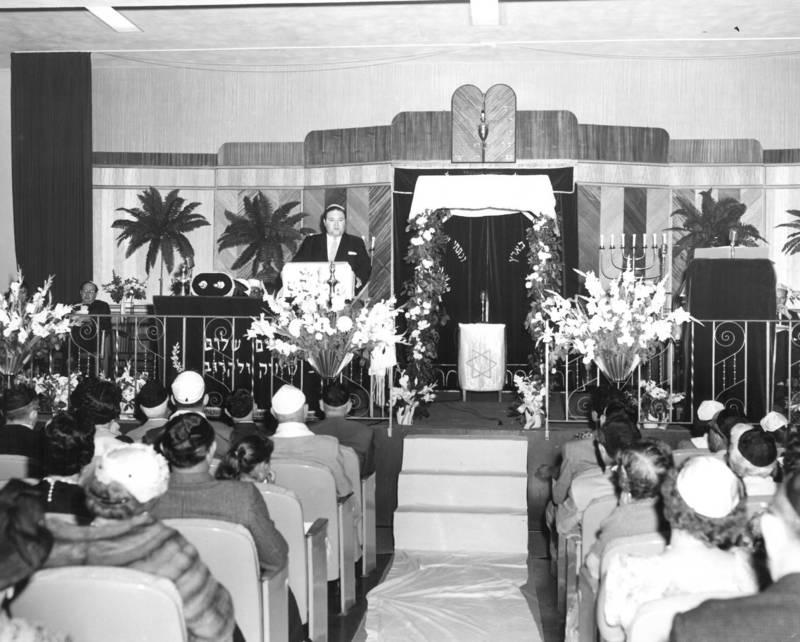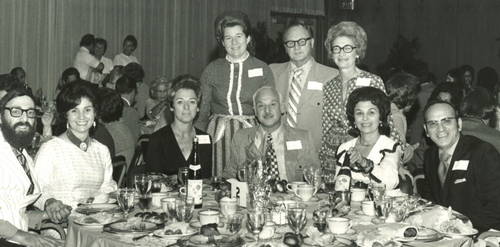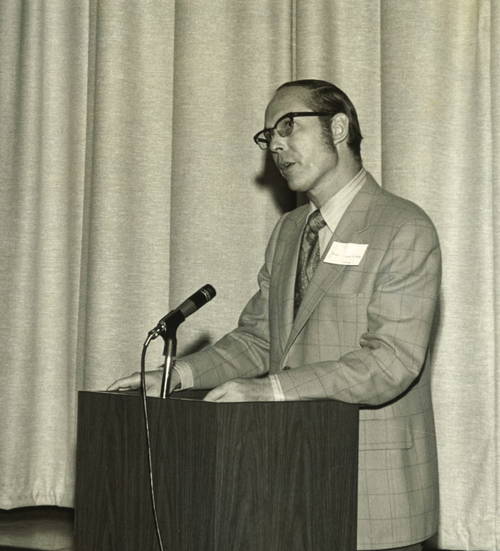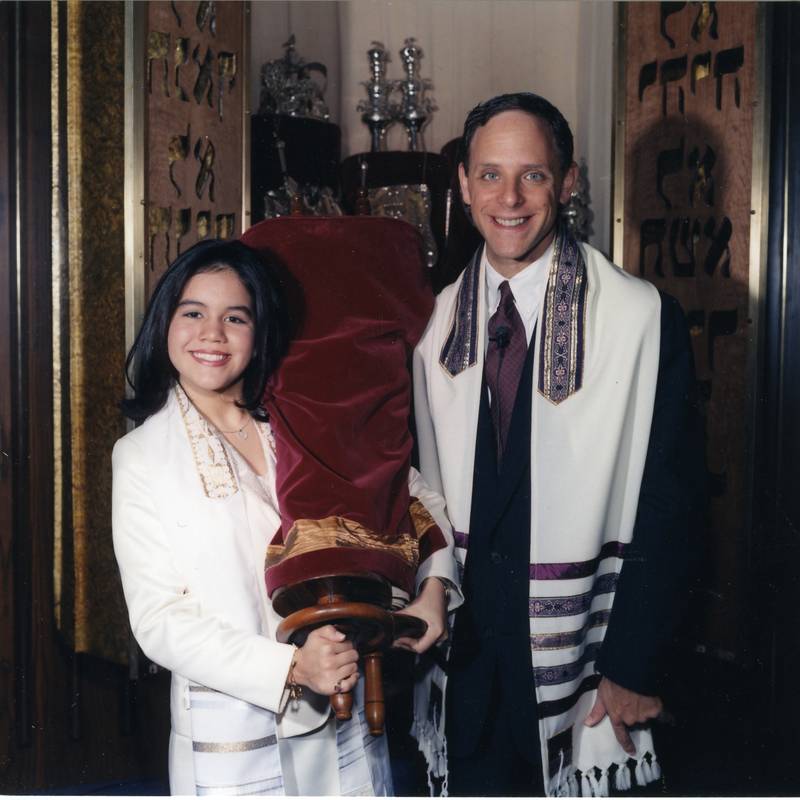
In 1946, a few Jewish families living in and around South Florida’s Coral Gables area began meeting in homes, storefronts, and at the University of Miami Hillel Center to worship and enjoy social gatherings. Their numbers increased, and in September 1948, our Pioneer Members officially formed the Coral Gables Jewish Center, joining the Union of American Hebrew Congregations, known today, as the Union for Reform Judaism.
 This was a period of profound change for the Jewish people worldwide. Our community’s formation coincided with the aftermath of World War II when millions of Jews were displaced following the Holocaust. Survivors and refugees sought safety and new beginnings, fueling waves of immigration to the United States and to what would soon become the modern State of Israel. In May 1948, the establishment of Israel offered a historic homeland after centuries of exile and persecution, inspiring Jewish communities everywhere, including those in South Florida. The Coral Gables Jewish Center was born in this climate of renewal, resilience, and hope.
This was a period of profound change for the Jewish people worldwide. Our community’s formation coincided with the aftermath of World War II when millions of Jews were displaced following the Holocaust. Survivors and refugees sought safety and new beginnings, fueling waves of immigration to the United States and to what would soon become the modern State of Israel. In May 1948, the establishment of Israel offered a historic homeland after centuries of exile and persecution, inspiring Jewish communities everywhere, including those in South Florida. The Coral Gables Jewish Center was born in this climate of renewal, resilience, and hope.
 In 1950, Rabbi Morris Skop and Cantor Joseph Malek were hired to lead the congregation, shortly followed by the construction of our first building on Palermo Avenue in Coral Gables. Six years later, the Coral Gables Jewish Center changed its name to Temple Judea.
In 1950, Rabbi Morris Skop and Cantor Joseph Malek were hired to lead the congregation, shortly followed by the construction of our first building on Palermo Avenue in Coral Gables. Six years later, the Coral Gables Jewish Center changed its name to Temple Judea.
In the early 1960’s, metropolitan Miami’s Jewish community was growing, and young families were moving further south. The leadership of the tion wanted to serve the needs of these families, and they began to evaluate how they could address this changing reality. In 1964 they hired Rabbi Morris Kipper who understood the needs of the current, more traditional families and was also able to attract young families. (He later became the founder of “ High School in Israel”.)
With the help of the University of Miami, Temple Judea was able to purchase our current prominent location on US 1 in Coral Gables. Designed by the world-renowned architect Morris Lapidus; Lapidus credited with creating the MiMo (Miami Modern) architecture was the visionary behind the Fontainebleau Hotel and the Eden Roc.
At that time Temple Judea’s membership was 400 families, the school program expanded to 6 hours each week, confirmation classes held retreats, and a strong high school youth program was developed.
Thriving and growing during the late sixties and early seventies, in 1973, Rabbi Michael Eisenstat came to Temple Judea he served for 23 years until 1996. During his tenure, in addition to all his other rabbinic duties, he authored extensive worship service liturgies, created the Annual community-wide Interfaith Day of Understanding, and established a weekly Soup Kitchen for the poor that still exists today.
 In 1996, Rabbi Edwin Goldberg became Senior Rabbi. Rabbi Goldberg and the lay leadership instituted remarkable changes in worship, education, and youth programs. Through worship transformation, both the music and the prayer book for Shabbat Evening services changed. The congregation's long-range planning effort resulted in the hiring of a full-time youth director and a full-time educational director. Youth programming touched the lives of more than 300 children annually, with active programs starting in kindergarten and continuing through senior high school. Our Religious School program has been continually updated to stay current with today’s continuing evolving reality.
In 1996, Rabbi Edwin Goldberg became Senior Rabbi. Rabbi Goldberg and the lay leadership instituted remarkable changes in worship, education, and youth programs. Through worship transformation, both the music and the prayer book for Shabbat Evening services changed. The congregation's long-range planning effort resulted in the hiring of a full-time youth director and a full-time educational director. Youth programming touched the lives of more than 300 children annually, with active programs starting in kindergarten and continuing through senior high school. Our Religious School program has been continually updated to stay current with today’s continuing evolving reality.
Through the years the congregation grew and expanded. Enhancements such as the Grossman Room, Silverman Music Room, Harrison Library and Reiter Pavilion, plus the sought-after Margaux Early Childhood School, were added. The Temple also added social action programs, such as the annual Mitzvah Day and involvement at local public schools.
Vast educational programming exists today including the Eric B. Meyers Scholar-In-Residence weekend; rabbi and staff-led youth trips to Israel, New Orleans, and Washington, D.C.; rabbi-led congregational travel abroad; and a wide range of support groups open to the community at large.
These changes equated to growth, requiring yet another renovation of the building to best serve the needs of the congregation as we moved rapidly into the 21st Century. The” Make it So” renovation was completed in September 2005.
In 2006 Temple Judea took the much-needed step of adding a second rabbi, engaging Rabbi Judith Siegal shortly after her ordination. Rabbi Siegal became involved in every aspect of Temple Judea’s operation, from delivering High Holy Day sermons, teaching learners of all ages, and fundraising for our Capital Campaign. Rabbi Siegal’s growing stature in Reform Judaism was also reflected by her election to the CCAR board in 2010.
In 2013 the congregation welcomed Rabbi Peter S. Knobel (z”l) as the intentional interim rabbi to serve one year while Temple Judea completed a thorough search for a new Senior Rabbi. And in 2014 Rabbi Judith Siegal was named Senior Rabbi, the first female senior rabbi in Temple Judea’s 65-year history. Rabbi Siegal’s vision is to create a “kehilla kedosha” or sacred community through relationship building and meaningful connections. Shortly after that Rabbi  Jonathan Fisch was hired as the assistant rabbi, bringing his energy and passion to our Jewish community from our youngest families to our most senior members. And, in 2016 a long-time dream was completed with the renovation and building of the Frank Family Education Center as a house of learning shared for generations.
Jonathan Fisch was hired as the assistant rabbi, bringing his energy and passion to our Jewish community from our youngest families to our most senior members. And, in 2016 a long-time dream was completed with the renovation and building of the Frank Family Education Center as a house of learning shared for generations. 
In 2023, rounding out our dynamic clergy team, Cantor Lisa Segal “came home” to Temple Judea bringing her extraordinary voice, musical leadership, and warmth, enriching both worship and our community’s spiritual life. In 2025 our community hosted a meaningful weekend of celebrations honoring the anniversaries of our beloved Rabbis: Senior Rabbi Judith L. Siegal’s 18th and Rabbi Jonathan R. Fisch’s 10th!
Today in our 77th year as the only reform congregation in Coral Gables, we are thriving with more than 700 member households, comprised of dedicated lay leadership, inspiring spiritual leaders, professional staff, and caring teachers. We are looking forward with promise and hope as we pave the way for the next generation with our LEV – From the Heart Capital Campaign reimagining our dynamic Temple Judea campus.
Since 1948, we have expanded upon the vision of our earliest founders seeking a safe Jewish space in a post war climate. In fact, our three historic entryway arches were designed as a physical symbol of core Jewish values where worship, learning, and assembly, flourish together. They remain as a Jewish beacon today welcoming all those to Temple Judea with inclusion, warmth, and purpose.
Foundational Statement
Through a strong Jewish community, we better ourselves and the world.

